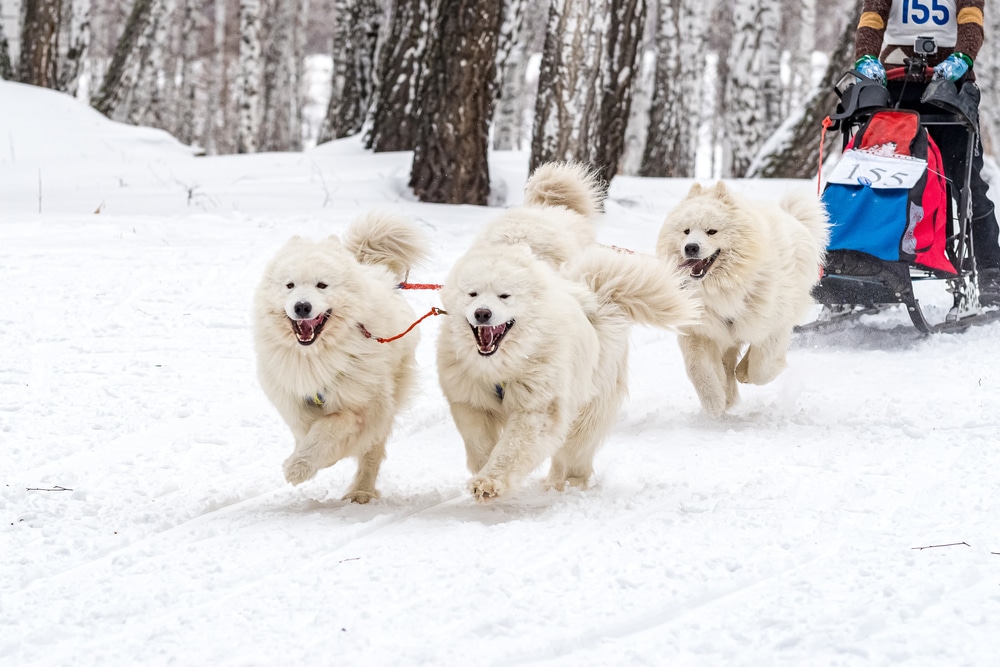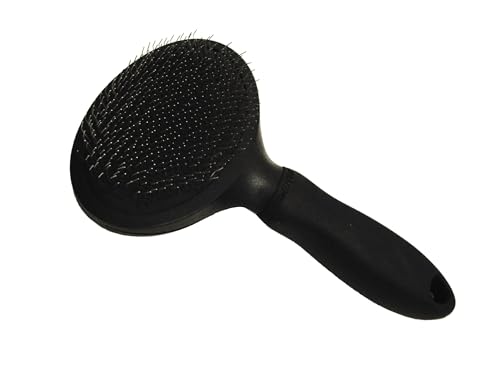Do you ever look down at your smiling happy Samoyed and say, “You have it easy.” And maybe your Samoyed responds with a tilt of its head. Putting on its best-confused face while smiling back at you. “I think it’s time we find you a job,” you say to your Samoyed as you pet the top of its head. Samoyeds love spending time with people. In fact, nothing makes them happier than spending hours on end playing with their owners. Their personalities are suitable for the service industry. With the right training and enough patience, a Samoyed service dog can help people through all walks of life.
Table of Contents
History

Throughout its development, the Samoyed has always been a service dog to humans. Originating in Siberia, the Samoyed served as a sled puller and herder for the Samoyede people. During cold winter nights, the Samoyede people would take advantage of the Samoyed’s thick double walled fur coat, using them as blankets to stay warm. Samoyeds were included in all family activities and loved connecting with tribes.
As pack animals, Samoyeds look to a strong alpha leader for guidance. When they are removed from their pack, their owners become alpha. Samoyeds are eager to please and will do anything to make their owners happy. Because of this, a Samoyed can adapt to service dog training. However, they require plenty of patience and persistence. They are active dogs who love their exercise and walking time. They are hyper, but with enough activity to wear them down, they remain calm and docile. Samoyeds are certainly not lone wolves, and they can’t stand being alone for more than 4 hours at a time. This makes them the ideal dogs for families or seniors who are usually home.
On the surface, Samoyeds appear too hyper to be obedient service dogs, but let’s delve into their personality to discover what makes them ideal candidates.
What Makes A Good Service Dog?

The good news is that with enough patience and persistence almost any even-tempered breed can be trained to become a service dog. Some breeds will excel past others, but most have the capabilities to do well. Samoyeds have an edge over other breeds due to their intelligence and compassion for people. They seem to have unique connections with humans, stemming from their time in Siberia.
Service dogs take on several roles. They help those with special needs and mobility issues navigate through daily life. They act as the eyes and ears for those with visual and auditory impairments. Service dogs also warn their owners of health concerns.
With mental illness being front and center in society, especially with the pandemic and humans spending more time indoors than ever, service dogs are in high demand. Service dogs can double as therapy dogs, and this is where the Samoyed can shine.
Smart Like A Samoyed
Samoyeds are intellectuals. If these dogs were students they would spend time in the library browsing through philosophy textbooks, in between runs around the gym of course! Not all dogs have the level of intelligence required to excel as a service or therapy dog. The Samoyed’s intelligence allows it to absorb new abilities and commands it learns in service training. Paired with the Samoyed’s intelligence is an eagerness to please. This means they will do whatever it takes to learn new commands and make their owners proud. Making their owners proud is the main goal of every Samoyed. Samoyeds are built to serve, and if their owners are happy, they are happy.
Samoyeds Are Extroverts

A service dog can’t behave like an animal in public. They need to be calm, reserved, polite, and approachable. Samoyeds have excellent socializing skills. They learn most of these skills at a young age if they are exposed to a loving group of people who care for them. A properly socialized Samoyed can control its aggressive side and make for an excellent service dog. Unfortunately, if a Samoyed is not socialized early in life, it is difficult for them to pick up socializing skills without extensive training. This doesn’t mean you can’t teach an old Samoyed new tricks, but professional help is required to turn them into a suitable service dog.
The Samoyed As A Therapy Service Dog
Through early socialization and exposure to loving humans, a Samoyed has the capability to excel as a therapy service dog. At a young age, a Samoyed should be exposed to children, loud noises, and adults. Therapy dogs console those with PTSD, anxiety, depression, and other mental strains. Compassion makes a Samoyed service dog ideal for addressing these mental health concerns. They are a natural communicator with people and a lot of it has to do with their appearance. Just one look at the Samoyed’s fluffy cloud-like coat can calm the busiest of minds.
Samoyeds are also friendly and outgoing which are essential traits for therapy dogs. Their high energy and playful behavior are uplifting to interact with. Often therapy dogs will visit retirement homes and children’s hospitals. They need to be ready to interact with all types of patients. Some patients may be aggressive, while others can be timid. A Samoyed’s temperament allows them to interact with all people in a friendly playful manner. Getting your Samoyed into therapy service training is rewarding for both of you. Your Samoyed gets to interact and be itself, while you get to watch your dog change people’s lives.
What A Samoyed Service Dog Isn’t Good At

Obviously, no dog is perfect, and a Samoyed service dog will have some flaws, as well. If you have mobility issues, then a Samoyed may not be the right service dog breed for you. You would think because of the experience Samoyeds have pulling sleds across snow-filled Siberian fields, they would be able to handle simple mobility tasks. However, due to the Samoyed’s medium build, pulling a wheelchair proves to be difficult for the breed. These tasks require a larger breed.
They also don’t fare well when monitoring their owner’s health status. Detecting fluctuations in health, such as insulin spikes, is not the Samoyed’s strong suit. There is an entire segment of the service dog industry dedicated to helping diabetics. These dogs are excellent at detecting blood sugar spikes. They do this after sensing changes in their owner’s scent which offers key indicators that blood sugar levels have changed. This job suits breeds such as golden retrievers and poodles. When a human’s blood sugar level changes, their body emits a certain smell, and these dogs are good at detecting this scent.
How To Train A Samoyed Service Dog
There are 2 methods of training a Samoyed service dog. One is complete owner control and the other is enrolling a Samoyed in services classes.
There are benefits to each method. A trainer with extensive experience and familiarity with the Samoyed breed will have an easier time teaching a dog than an owner. Sending your Samoyed to a trainer can be worth the cost just for this experience alone. As an owner, you may not have a lot of time to dedicate to training your Samoyed to be a service dog. With a full-time job and kids, this task becomes almost impossible. If you only want to train your Samoyed to be obedient, then this is absolutely a task you can handle on your own. There are several books available to help you bring the best out of your Samoyed.
- Amazon Kindle Edition
- Naiyn, Doug K (Author)
- English (Publication Language)
- 10/03/2020 (Publication Date)
However, if you’re looking to take your Samoyed to service dog standards, then the professional route is the best option.
The Cost Of A Samoyed Service Dog

Choosing to buy a Samoyed service dog over other similar-sized service breeds like golden retrievers, Labrador retrievers, and German shepherds will be harder on your wallet. The popularity and demand for Samoyeds are high and breeders will charge accordingly. Typically a Samoyed puppy will cost between $700-$1,500 USD depending on your area and breeder. If you are looking to buy a Samoyed from a specific bloodline, prices can soar to $3,000 USD. Owning a Samoyed comes with its own set of costs including extensive grooming equipment to maintain their elegant appearance.
- Includes one Miracle Care Large Slicker Brush for Dogs
- Soft pad and angled, flexible pins allow for effective grooming without irritating dog's skin; larger head suitable for use on large dogs
- Effectively reaches the undercoat on double coated breeds to finish the coat; Cushioned and ergonomic designed grip prevents hand and wrist strain
- From Nose to Toes We've Got Your Pet Covered: Our goal is to improve the human-animal bond by offering a complete line of innovative, solutions- driven products and accessories for animals, both small and large
- Our health & grooming aids have been used and recommended by top veterinarians and professional groomers for more than 40 years
Conclusion
In conclusion, a properly socialized Samoyed offers the people skills and appearance to be a candidate for a therapy service dog position. Samoyeds trained at a young age can use their people skills to lift the spirits of those suffering from mental illness, especially in this time of extreme isolation. Samoyeds are not ideal mobility service dogs.
Additionally, they are not ideal for alerting their owners of changes in their health. A Samoyed service dog will be more expensive than other service dog breeds, but their smile and cloud-like coat alone is worth the price. It seems like just the sight of a Samoyed works wonders for people in all walks of life!
Do you own a service dog? What breed was best for you? Let us know in the comments below!


